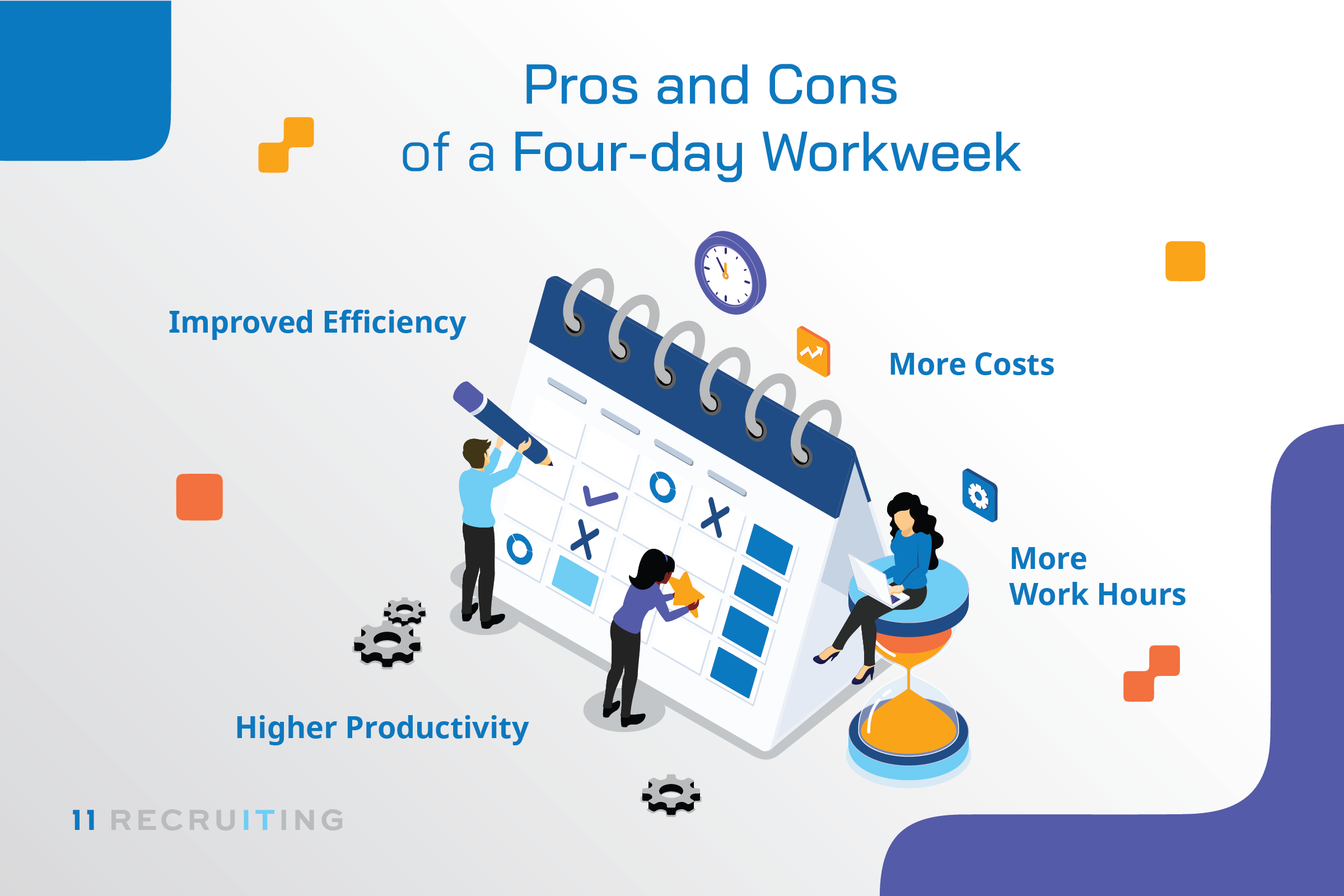
There is a new trend in the working world; people work fewer hours but get paid the same. The four-day workweek could mean that you have three days off work instead of the usual two. Additionally, you’d have more time to do personal stuff.
As tempting as it may sound, this flexible work model comes with its fair share of advantages and disadvantages. In this article, we will unravel the pros and cons of a 4day work week.
Different Work Schedules
Work schedules refer to specific days and times that employees should perform tasks related to their employment. Here are the most common types of work schedules.
- 4-day workweek: A four-day workweek allows full-time employees to work their usual 8 hours a day for four days a week instead of five. It’s common for people to confuse a four-day workweek with a compressed workweek.
- Compressed workweek: Compressed work schedules are such that the employees work four days a week but with compressed hours to meet the usual 40 hours a week. Workers work a 10-hour shift daily to meet the 40 hours requirement.
- 5-day workweek: A five-day workweek is the 9-5 Monday through Friday schedule. With this schedule, employees work for about 40 hours a week. Many companies apply this method because it’s thought to help workers remain productive.
- Flexible schedules: A flexible schedule can change depending on company policies. Some businesses allow employees to work certain days at home and other days at the office. Flexibility could also mean that employees don’t have a strict schedule for arriving or leaving the office.
- Fixed schedules: Fixed schedules rarely change throughout an employee’s employment duration. The schedule could be that a worker reports to work at eight and leaves at 4 Monday through Friday.
- Part-time schedules: A part-time schedule gives employees complete control over their time because they get to work at their preferred times. A part-time worker can schedule other activities like school or house chores. Part-time workers don’t have the full benefits given to full-time ones.
- Full-time schedules: A full-time schedule allows employees to work the same days and time each day. The schedule involves working 40 hours a week either at an hourly rate or an agreed salary.
FAQs
What countries have a four-day workweek?
Companies in Iceland, Spain, and Japan already use the four-day workweek schedule. Leading brands such as Microsoft and Unilever have trialed the schedule since 2019. They claim that employees are happy and productivity has increased since then.
What is the most ideal work schedule?
An ideal work schedule is fixed, where employees work a 9-5 shift daily, Monday through Friday. It is considered suitable because it’s easy to manage and employees are accustomed to it.
Are 37.5 hours full-time?
Depending on company policy, the hours considered full-time might vary. Some companies consider 37.5 hours full-time after deducting a 30 minutes unpaid lunch break daily. Other companies give one-hour lunch breaks that aren’t paid, leaving 35 hours’ work time.
Pros and Cons of a Four-day Work Week
Like any other model, the four-day workweek has its advantages and disadvantages.

Pros
Here are some of the reasons you should adopt a 4-day workweek for your business.
- Employee satisfaction: When employees have more time to do the things they love, they will be happy. Happy employees will perform better and become loyal to the company. As a business, employee retention is crucial because replacement costs exceed retaining the already existing workforce.
- Increased productivity: Contented employees tend to focus more on their work. On the contrary, when employees are disgruntled, they will not work as expected and distract their colleagues.
A New Zealand firm trialed a 4 day work week and found that performance increased to 78 %, from 58 %. The workers said that they had more time to rest and performed better at work.
- Lower operation costs: a four-day workweek saves expenses for the employees and the business as well. The employees save on commute costs, lunch, and snacks. The company also saves on running costs such as water, electricity, and meals for those that provide.
- Reduced cases of burnout: Mental health-related problems have been on the increase in the 21st century. People are working extra hours to manage their lifestyles. Companies are also overworking employees trying to make more sales. Sadly, working many hours leads to burnout and stress that affect employee productivity.
Giving employees control over their time helps them balance work and personal stuff. Having time to do the things they love reduces the chances of burnout and stress.
Cons
Here are some of the challenges your business will likely face if it adopts the four workdays model.
- Reduced income: It’s all fun and games when you have three off days in a week, but this all changes when you have to face a pay cut. Some companies have used the four-day workweek to cut costs by reducing salaries. For example, the Los Angeles Times cut employee pay by 20 percent in 2020 after introducing the four-day workweek.
- Not applicable for all businesses: As much as all businesses want to jump on this moving trend, it’s not applicable for all business models. Service provision businesses can’t work for only 4 days because customers have nobody to serve them. Imagine if a fire erupted in a building on Friday, but all firemen don’t work that day?
- Difficulties balancing the work shifts: Assuming your business cannot afford to close for a day. it would mean creating shifts. Balancing the shift patterns may be challenging for the management. Ideally, some days of the week may become highly contested over others.
Many workers would want to have their off day on a Friday or Monday to have a long weekend. The model will create a problem if the management creates a random rotational shift without asking for employee input.
- Expensive for businesses: A shrewd business owner may view reduced work hours with the same pay as an expense. It worsens if productivity doesn’t increase because it means hiring more people to get work done. It’s advisable to try the schedule out with a few departments before a business goes all-in with it. This way, it’s possible to determine whether it’s viable for the company.
Did you find this article helpful? Take a look at similar articles on our blog.

